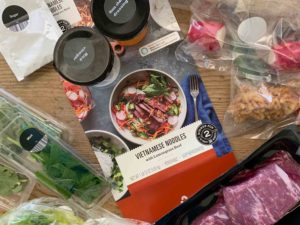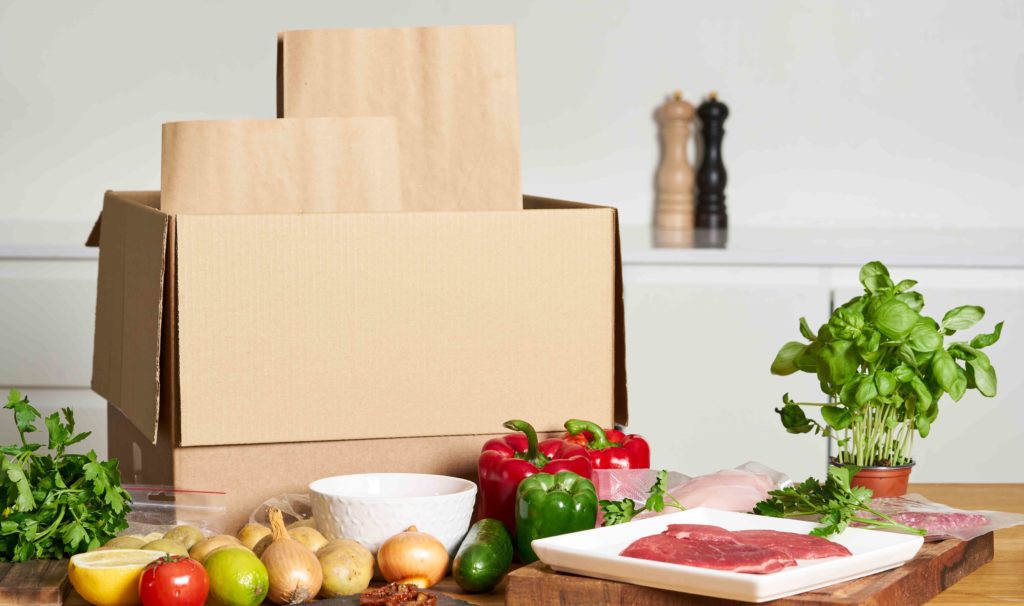Meal kits have found success in a busy but food-conscious world, growing into a $1.5 billion industry in the United States last year after entering the market less than a decade ago. Now, the COVID-19 pandemic has fueled their growth further, reporting increases in revenue of at least 20% between April and June 2020.
Beyond the traction gained through lockdowns, however, these meal kit services have also been growing in popularity with the idea that they can be used to reduce food waste and even carbon footprints. But do these meal kits really reduce waste and if so, how?
Meal kit food waste — Less time, less trash
A meal kit service is a subscription-based company that sends pre-portioned, and sometimes pre-prepared, ingredients along with recipes to subscribers so they can cook meals at home. And it is this pre-portioning that is key to reduction in food waste.
 When it comes to food waste one of the biggest problems we face is consumers overbuying produce, leading to it sitting in fridges and cupboards and eventually being thrown in the trash. This can be due to actual spoilage or the misinterpretation of expiry labels, but combined, household food waste accounts for around 27 million tons of food waste per year.
When it comes to food waste one of the biggest problems we face is consumers overbuying produce, leading to it sitting in fridges and cupboards and eventually being thrown in the trash. This can be due to actual spoilage or the misinterpretation of expiry labels, but combined, household food waste accounts for around 27 million tons of food waste per year.
Meal kits can minimize this waste by delivering precise quantities of ingredients for each meal, reducing the amount of food that is wasted to spoilage, as well as the leftovers produced. In fact, some research has found that compared with non-tailored meals, these kits can cut food waste by more than two-thirds.
It isn’t just in people’s homes where food waste can be reduced, however, since meal kit services, through their subscription models, also have the ability to accurately predict the quantities they need to purchase from wholesalers.
Consumer-facing businesses such as grocery stores account for around 25 million tons of food waste a year in America, only a fraction less than consumers, and much of this is due to overstocking fresh produce to give the appearance of abundance, alongside the ability to sell throughout the day without running out. With accurate subscription numbers, meal kit services circumvent this issue.
While it is true that meal kit food waste is low, these single-serve meals create a different problem of packaging waste—far more packaging than if you were to buy produce loose from a grocery store or market.
Meal kit packaging waste: A bigger problem?
These delivery-based products must have packaging to preserve the ingredients—at minimum a single box, but more often, individual packets for every ingredient along with possible lining, icepacks, recipe cards, and more.
 In fact, the film and flexibles program director at the Association for Plastic Recyclers (APR) found that three kits from different companies “each had more than two dozen different packages, including one with 31” pieces of packaging, and that the majority of this meal kit packaging waste was plastic. What’s more, many of these plastics weren’t recyclable—some were too small to make it through the plastic recycling process, others were made of mixed materials or had large, contaminating labels.
In fact, the film and flexibles program director at the Association for Plastic Recyclers (APR) found that three kits from different companies “each had more than two dozen different packages, including one with 31” pieces of packaging, and that the majority of this meal kit packaging waste was plastic. What’s more, many of these plastics weren’t recyclable—some were too small to make it through the plastic recycling process, others were made of mixed materials or had large, contaminating labels.
One part of the meal kit packaging that has caused particular concern is the ice packs that come in these boxes to keep them fresh. As early as 2016, the APR began getting reports from reclaimers and material recovery facilities about the insulation from meal kit services showing up in their supply streams. And, to no surprise, these are rarely recycled due to the rigorous clean and dry steps needed for plastics, and they often contain chemicals that need disposed.
The meal kit services’ general solution is to reuse these ice packs—a good idea, in theory since it sits higher on the waste-management hierarchy—but with regular delivery of these kits, there are only so many bags of frozen gel you can keep stored in a freezer.
In the foreseeable future, it seems that this problem will continue, with many services listing how to recycle their packaging rather than reducing meal kit packaging waste. However, waste isn’t limited to what ends up curb-side, which has encouraged some people to look at the overall environmental benefits these kits could have.
Overall meal kit waste — An acceptable tradeoff?
Interestingly, when you look at meal kit waste in a more holistic fashion, balancing the excess of packaging against the greatly reduced food waste and improved logistics, it might actually “balance out”. In the sense of overall environmental impact, that is, with one study finding that grocery meal greenhouse gas emissions are actually 33% higher than meal kits, which is mainly down to the reduction of food waste.
 That said, another study of the same year (2019) found quite the opposite, noting that “even if delivered meal kits reduced food waste to zero, they would still use up more energy overall than buying the same food from the supermarket unless the energy used for the meal kit packaging was cut by a fifth.”
That said, another study of the same year (2019) found quite the opposite, noting that “even if delivered meal kits reduced food waste to zero, they would still use up more energy overall than buying the same food from the supermarket unless the energy used for the meal kit packaging was cut by a fifth.”
It would seem that meal kit services could offer some environmental benefits but only if there are changes—and cutting packaging by a fifth isn’t an overly ambitious target. As to whether they save waste? In some ways, yes, with meal kit food waste being a fraction of the norm. However, this is offset by the excess of packaging — especially single-use plastics.
To learn more about reducing and recycling both food waste and plastics, subscribe to our blog. Additionally, get more information on improving waste and recycling practices in your business by speaking to one of our TRUE Waste Advisors.

